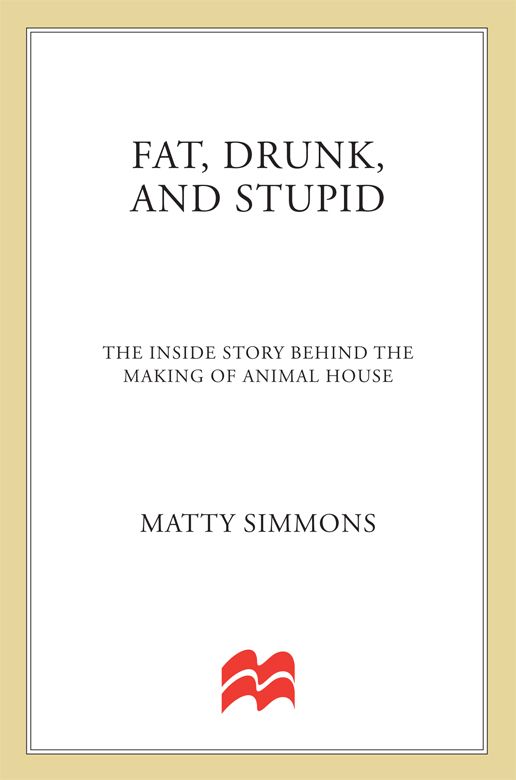
Fat, Drunk, and Stupid
The Inside Story Behind the Making of Animal House
کتاب های مرتبط
- اطلاعات
- نقد و بررسی
- دیدگاه کاربران
نقد و بررسی

December 12, 2011
Animal House producer Simmons takes a fond look back on the “little movie” that turned into a blockbuster, made John Belushi a star, and spawned dozens of badly made imitations. As the moneyman behind the success of the legendary National Lampoon magazine, Simmons helped put together the team that conceived of the tale of two warring fraternities in the early 1960s—the wacky Deltas and the evil Omegas. Simmons provides interesting but all-too-brief looks at the “volatile, mad creator” and Lampoon editor, Doug Kenney; National Lampoon Show actor and future director, Harold Ramis; and Lampoon writer Chris Miller, who used many of his experiences at Dartmouth College in the final script (and who actually lived in a frat called “Delta House”). Simmons had a front-row seat at the film’s creation, and he provides a detailed look at how the movie was made, as well as its unanticipated success. He offers some interesting anecdotes (especially a deleted scene in which the Deltas give a car ride to a young, then unknown Bob Dylan only to throw him out after he starts singing), but overall, Simmons covers much of the same territory as various other books about the film, its actors, and the National Lampoon, and his writing is surprisingly flat (“It seemed it had taken forever to get the movie green-lighted—and then just the briefest blink of time to get it shot”).

January 1, 2012
Animal House fans will find some anecdotes of interest, but there is barely enough here for a comprehensive magazine article on the making of the classic movie. As the publisher of National Lampoon and co-producer of its first movie smash, Simmons (The Credit Card Catastrophe: The 20th Century Phenomenon That Changed the World, 1995, etc.) worked with a wide variety of funny people and writers. Unfortunately, in these pages there are too few of them and too much of Simmons, who frames his account with his early years "as a very young press agent in the 1950s" through his launching of magazines for Diner's Club and Weight Watchers, and culminates in an afterword that begins: "So, Animal House made me a film producer and for three decades people have been asking me what a producer does. I will tell you." The author mainly shows himself to be a master of hyperbole, bathing every aspect of the production in superlatives: "It became more than a movie. Animal House changed comedy"; "casting, particularly of the young Deltas and Omegas, was superior to any comedy movie before or after Animal House"; its screenplay was "the tightest 110 pages of writing I had seen before or I have seen since." Throughout the book, Simmons provides too little revelation about the shooting itself or insight into the talent involved. Instead, the text is padded with excerpts from dozens of reviews, summaries of outtakes and accounts of what those who participated did before the movie and where their careers have gone since. The title and cover promise the sort of hilarious irreverence that the book rarely delivers.
(COPYRIGHT (2012) KIRKUS REVIEWS/NIELSEN BUSINESS MEDIA, INC. ALL RIGHTS RESERVED.)

February 1, 2012
As both the producer of Animal House and founder of the humor magazine National Lampoon (from which the film emerged), Simmons brings a singular perspective to this behind-the-scenes book. He contends that the comedic sensibility of Animal House--black, taboo-breaking, and aimed toward young people--not only made it a smash hit but also convinced college students that they were free to do what they wanted. Descriptions of audience reactions are most striking, including the first test screening in Denver, where everyone "literally stood on their seats and screamed." Simmons's tone is breezy, and he offers amusing anecdotes about cast members as well as nuggets of information about the financial aspects of the film. Pacing is a problem, though, with a bloated "where are they now" chapter contrasting skimpier but more appealing and relevant context about National Lampoon. VERDICT Animal House enthusiasts will find elements to enjoy here, but for those interested in learning more about National Lampoon's style of humor, Josh Karp's A Futile and Stupid Gesture is a better option.--Christopher Martin, Univ. of Dayton Zimmerman Law Lib.
Copyright 2012 Library Journal, LLC Used with permission.

April 1, 2012
In the mid-1970s, Simmons was riding high as publisher of the wildly popular humor magazine National Lampoon. The publication's success spawned an entire industry, including live theatrical shows, radio programs, books, and comedy albums. But its most successful spin-off was just on the horizon, the classic 1978 film National Lampoon's Animal House. Simmons and most of the movie's top-shelf talent, including fellow producer Ivan Reitman, director John Landis, and a then-unknown Kevin Bacon, take a fond look back at the raucous making of their underdog production, which became an unexpected blockbuster, turned the late John Belushi into a superstar, and, according to the book, changed the course of mainstream American comedy forever. Animal House is the granddaddy of the gross-out genre that includes American Pie, but Simmons argues it was the daringly subversive political commentary and gut-busting jokes that set it far above all followers. Previous books have covered similar ground, and Simmons' writing style is more fizz than pop, but loyal fans of Animal House will find much to like in this engaging read.(Reprinted with permission of Booklist, copyright 2012, American Library Association.)

























دیدگاه کاربران